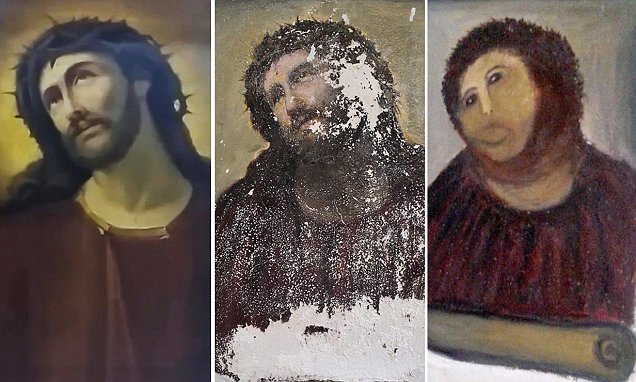
You will likely remember the (somewhat) recent restoration of Ecce Homo in Spain that resulted in a rather different representation of Jesus in the newly finished product. It quickly became a meme and has since been circulated widely on the internet. It came to mind after seeing this following video about art restoration. Take a look:
The video takes us through the process of the restoration of Mother Mary to demonstrate the ways in which art is maintained to last. But as I was watching the video, I began to wonder when restorations are considered to be good and necessary and when they are considered to be destructive. As shown in the video, much care is taken with the restoration process — every detail attended to with great care. While the finished restoration of Mother Mary is, to the casual observer, far more similar than that of Ecce Homo to the worn image we see in the beginning of the video, are the restorations of the two all that different, practically speaking?
Hear me out…
For the art purist — perhaps even for the art historian — when does the notion of authenticity allow for some leeway? While I’m sure great care was taken to match the colors and style of Mother Mary, the finished restoration is not the “original” painting, but an attempt at depicting it. The restoration was refurbished with modern tools, paints, chemicals (though some other restorations do use historic materials). After all, there are several ways to test artwork so to determine whether it is the original or a forgery.
While the quality of the restored Mother Mary may be far and above that of Ecce Homo, neither is unchanged. Of course, this isn’t an argument for authenticity or lack thereof, but rather an observation about when claims of authenticity are employed and how. After all, like the man in the above video, there is an entire profession made out of art conservation which provides services to museums and private collectors. But are these pieces still “authentic,” now that the original has been altered? Is the deteriorated painting which has flaked due to exposure to moisture, been torn and punctured, and gathered dust and grime considered to be more “authentic” before restoration? Or is it just a painting that needs to be restored to appear as we think it would have when initially painted? Considering the profession of conservationists, it would seem that a restored painting is deemed more authentic (read: valuable, perhaps?). The issue then seems to be less of authenticity and more of similarity to the so-called original.
Perhaps you’re familiar with Orson Welles’ 1973 film F for Fake, a film about art fakes and forgery. If not, take a look at the trailer:
While neither Mother Mary or Ecce Homo are forgeries, neither are they unaltered pieces. However, one restoration is presented as a recovery of the original artwork and the other is seen as irrevocably destroyed. Authenticity, then, appears to have less to do with whether a piece is, in fact, exactly as it was (i.e., original) and more to do with how it appears despite alterations. So long as it is similar enough, we can ignore the modern adaptations and corrections to something where they didn’t exist previously so long as they don’t draw too much attention.
Or, as argued in the F for Fake trailer:
“The important distinction to make, when you’re talking about the genuine quality of a painting, is not so much whether it’s a real painting or a fake: It’s whether it’s a good fake or a bad fake.”
